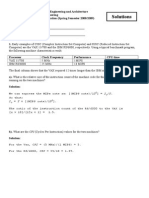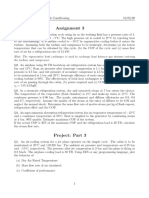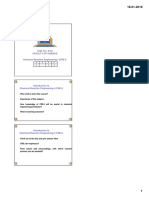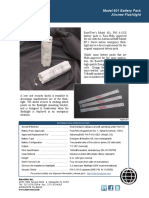Test 1 With Ans
Test 1 With Ans
Uploaded by
Kavinesh GanesanCopyright:
Available Formats
Test 1 With Ans
Test 1 With Ans
Uploaded by
Kavinesh GanesanOriginal Title
Copyright
Available Formats
Share this document
Did you find this document useful?
Is this content inappropriate?
Copyright:
Available Formats
Test 1 With Ans
Test 1 With Ans
Uploaded by
Kavinesh GanesanCopyright:
Available Formats
Test 1 Questions
1. Two tanks are connected as shown below, both containing water. Tank A is at 200kPa,
specific volume 0.5m3/kg and volume 0.1m3. Tank B contains 3.5kg at 0.5MPa, 400°C. The
valve is now opened and two tanks come to uniform state.
(saturated mixture, superheated vapor, mA1=0.2kg, VB1=2.16m3, vtotal=0.61093m3/kg,
16550.041 kJ)
a. What are the initial states of both tanks (4 marks)
b. Determine the total mass of the water in tank A (2 marks)
c. Calculate the volume of tank B (2 marks)
d. Find the final specific volume (2 marks)
e. Determine the heat transfer when the system reaches thermal equilibrium with
surrounding at 25°C ( 20marks)
T
xx
A B
2. A piston cylinder device contains 1kg of air undergoes a series of processes. Initially the
pressure is 0.1 MPa and temperature of 20°C. The air is compressed isothermally to 0.6MPa.
Then it is heated at constant pressure until the volume increased to 0.2m 3. Asume air to
behave as an ideal gas. (v1=0.8409 m3/kg,v2=0.1402 m3/kg, T3=417 oC, w21=-150.64
kJ/kg(compression), w32=35.88kJ/kg(expansion), q21=-150.64 kJ/kg (heat out), q32=128.087
kJ/kg (heat in)
a. Determine pressure, temperature and specific volume at each state ( 5 marks)
b. Calculate the work per unit mass, w for each process and determine whether it is an
expansion / compression work (10 marks)
c. Find the heat transfer per unit mass, q for each process and determine whether the is
heat transferred in/out ( 10 marks)
d. Show the process in P-v diagrams ( 5 marks)
Last update 24/03/2020
3. A piston-cylinder device with a volume of 0.035 m 3 (refer Figure below) contains
refrigerant R134-a at 400 kPa (State 1). Initially 20% of the volume is liquid and the rest is
vapor. Then heat is added to the system until the piston is just touching the stopper (State 2).
At this state, all the R-134a exists 100% as vapor. Heating is continued until the pressure
inside the piston reaches 600 kPa (State 3).
(mtotal=9.4kg, x=0.05, W31=178.52 kJ, Q32=2590.36 kJ)
stopper
Q R-134a
Answer the following questions:
a. What is the total mass and quality of refrigerant R-134a inside the piston at initial state.
(5 marks)
b. Determine the boundary work from State 1 to State 3 (in kJ). (10 marks)
c. Determine the amount of heat from State 1 to State 3 (in kJ). (10 marks)
d. Show theses processes on a well-labled T-v and P-v diagrams. (5 marks)
4. A 100kg of refrigerant R134a at 200 kPa are contained in a piston cylinder device which
volume is 12.322 m3. The piston is now moved until the volume is half of its original size.
The process is done under isobaric condition. Answer the following questions (superheated
vapor, x=undefined, v2=0.06161m3/kg, -110.47 kJ/kg)
a. what are the state and quality of the refrigerant R134a inside the piston at initial state
b. determine the final specific volume and temperature of refrigerant R134a
c. calculate the change in the total internal energy of the refrigerant R134a
d. show the precess on P-v diagram
5. A piston cylinder device contains 2.2.kg of nitrogen initially at 100 kPa and 25 oC. The
nitrogen is now compressed slowly in a polytropic process during which PV 1.3=constant until
the volume is reduced by one-half (P2=246.23 kPa, T2=366.88 K, W21=-149.92
kJ( compression work/work done on the system), Q21=-37.2 kJ(heat out)
a. state all your assumptions
b. calculate the pressure and temperature of the final state
c. determine work done and the heat transfer for this process. Please give comment for the
answers you get for work and heat transfer
Last update 24/03/2020
6. A well-insulated piston cylinder device contains 5L of saturated liquid water at a pressure
of 175 kPa. The water is heated to 200 oC electrically and it is stirred by a paddle-wheel. The
amount of paddle wheel work is1000 kJ. (4.73kg, 10.28MJ)
(a) Determine the mass of water (2 marks)
(b) Determine the electrical work supplied in MJ (11 marks)
(c) Show the process on a P-v diagram with respect to saturation lines
(2 marks)
7. Consider a frictionless piston cylinder containing 2.0 kg carbon dioxide (C p = 0.846 kJ/kg
K) with initial conditions at 1 bar and temperature 27oC. The system undergoes a cyclic
process as indicated below:
1-2: The gas undergoes a polytropic process with PV n= constant and n = 1.5.The volume of
carbon dioxide is reduced and its volume is ¼ from its initial volume.
2-3: The gas is further compressed at constant pressure.
3-1: Finally the gas is expanded according to PV = constant back to its initial condition.
Determine
(a) P2 and V3 (800kPa, 0.1417m3) (3 marks)
(b) Heat generated for each process (-29.55 kJ, -310.47 kJ, -235.68 kJ) (10 marks)
(c) Construct process on a P-V diagram (2 marks)
8. (a) Determine whether heat or work taking place in the following system:
(i) The car radiator.
(ii) The car engine.
(iii) Fan inside a room.
(b) Water is being heated in a closed pan on top of a range shown in Figure 1 while being
stirred by a paddle wheel. During the process, 30 kJ of heat is transferred to the water,
and 5 kJ of heat is lost to the surrounding air. The paddle-wheel work amounts to 500
J.
(i) Write all your assumption(s).
(ii) Identify your system.
(iii) Determine the final energy of the system if its initial energy is 10 kJ. (12 Marks)
Last update 24/03/2020
9. Figure 2 shows a piston cylinder device with stops. Initially the cylinder contains
saturated water vapour at 3.5 MPa before being superheated which cause an
increment of temperature by 5C. When the steam loses heat to the surrounding, the
piston moves down and hit the stops. At this stage, the cylinder contains saturated
liquid water. The cooling process is keep continuing until the temperature drop to
200C. Determine:
i. The temperature after being superheated. (247.6 oC)
ii. Enthalpy change of the system from superheated to saturated liquid water in
kJ/kg. (-1771 kJ/kg)
iii. Final pressure and the quality (if any). (1555 kPa, 0.0006)
iv. Show the process on a T-diagram.
o
10. A 10L rigid tank contains R134a at -10 C, 80% quality. A 10A electric current (from a 6V
battery) is passed through a resistor inside the tank for 10 min, until the temperature becomes
o
40 C. Determine:
a) Mass of R134a and the final pressure in the tank. (0.125 kg)
(b) Electrical work (current x voltage x time given that 1 kJ/s=1000 VA). (36 kJ)
(c) Heat transfer to or from the tank during this process. (-26.69 kJ)
Last update 24/03/2020
You might also like
- Sample 2022-23 Student Planner SundayDocument78 pagesSample 2022-23 Student Planner SundaynataliaNo ratings yet
- Problem Set No. 3Document1 pageProblem Set No. 3CJ GoradaNo ratings yet
- Pricing Maths Tutorial (Case Study On WALMART)Document4 pagesPricing Maths Tutorial (Case Study On WALMART)Goody Boy FahimNo ratings yet
- PBL1Document19 pagesPBL1Nguyen NamNo ratings yet
- Notes-Ch 10. Sinusoidal Steady-State Analysis PDFDocument39 pagesNotes-Ch 10. Sinusoidal Steady-State Analysis PDFnanekNo ratings yet
- Stability PDFDocument64 pagesStability PDFGlan DevadhasNo ratings yet
- EE215 Lab4Document7 pagesEE215 Lab4Lynn FranklinNo ratings yet
- Ed 4Document2 pagesEd 4Vaibhav KumarNo ratings yet
- BTL VuTrongHau 20202618Document89 pagesBTL VuTrongHau 20202618HauvuNo ratings yet
- CH 17Document43 pagesCH 17ዝምታ ውስጤ ነውNo ratings yet
- Mechatronics AssignmentsDocument2 pagesMechatronics AssignmentsKeith Magaka100% (1)
- Problems 18.1: Corrosion-Resistant Materials: Stainless SteelsDocument1 pageProblems 18.1: Corrosion-Resistant Materials: Stainless SteelsAulia HafidzNo ratings yet
- Ejercicios Del Tema 1 y Tema 2 - Estatica Beer Jhonson 9edDocument11 pagesEjercicios Del Tema 1 y Tema 2 - Estatica Beer Jhonson 9edJean Pierre MoralesNo ratings yet
- Probset 1bDocument12 pagesProbset 1bRegina Marie MaximoNo ratings yet
- Cau Hoi On Tap Dien Dien Tu EngDocument10 pagesCau Hoi On Tap Dien Dien Tu Engthang nguyenNo ratings yet
- Tesla Coil ProjectDocument9 pagesTesla Coil ProjectAyush RanjanNo ratings yet
- AE1304 Propulsion IDocument8 pagesAE1304 Propulsion ISriram100% (1)
- ktra hệ thống sản xuất tích hợpDocument47 pagesktra hệ thống sản xuất tích hợpVũ Quốc KhánhNo ratings yet
- Reading 1Document20 pagesReading 1Hwee Peng YeoNo ratings yet
- BJT Model From DatasheetDocument14 pagesBJT Model From DatasheetAngel Pérez SantiagoNo ratings yet
- Heat Transfer Lab 1Document12 pagesHeat Transfer Lab 1SAMARTH TIWARINo ratings yet
- Kte 5000LTDocument110 pagesKte 5000LTzalomxisNo ratings yet
- Tutorial 6Document3 pagesTutorial 6Hoài ThươngNo ratings yet
- 19 Petrucci10e CSMDocument52 pages19 Petrucci10e CSMElah PalaganasNo ratings yet
- Entropy ReportDocument27 pagesEntropy ReportMbadrul Uyun100% (1)
- Exercise5 Solution - Introduction To Embedded SystemsDocument7 pagesExercise5 Solution - Introduction To Embedded Systemsquoctrung244No ratings yet
- Borgnakke's Fundamentals of Thermodynamics: Global EditionDocument86 pagesBorgnakke's Fundamentals of Thermodynamics: Global Edition정윤서No ratings yet
- Assgnment 1Document3 pagesAssgnment 1Akash Singh TanwarNo ratings yet
- PCHEMDocument11 pagesPCHEMMika PelagioNo ratings yet
- Clamp MeterDocument3 pagesClamp MeterKerin Berliana100% (1)
- Feedback Chap 2 HWDocument13 pagesFeedback Chap 2 HWAudreyWalangareDimalibotNo ratings yet
- UNIT-1: What Is The Difference Between Refrigeration & Air Conditioning?Document8 pagesUNIT-1: What Is The Difference Between Refrigeration & Air Conditioning?Udit NarayanNo ratings yet
- Analog Electronics-3 PDFDocument39 pagesAnalog Electronics-3 PDFAbhinav Jangra100% (1)
- Problem Sheet 4 - Internal Forced Convection - WatermarkDocument1 pageProblem Sheet 4 - Internal Forced Convection - WatermarkUzair KhanNo ratings yet
- Tutorial Pneumatic CircuitDocument5 pagesTutorial Pneumatic CircuitMuhammad Abdullah0% (1)
- All Tutorials ChE 313Document12 pagesAll Tutorials ChE 313Gio Albert BesaNo ratings yet
- ch09 PDFDocument132 pagesch09 PDFdaler12345No ratings yet
- Tele Traffic LectureDocument18 pagesTele Traffic LectureDramane BonkoungouNo ratings yet
- First Problem Set 2nd Sem AY1718Document14 pagesFirst Problem Set 2nd Sem AY1718Gel ValleNo ratings yet
- MODULE 2: Worked-Out ProblemsDocument22 pagesMODULE 2: Worked-Out Problemscaptainhass100% (3)
- Final 222 2009 SolDocument6 pagesFinal 222 2009 SolNapsterNo ratings yet
- Chương 6: 6.1. The Eye Can Be Treated, To A First Approximation, As A Thin - x0002 - Walled ElasticDocument39 pagesChương 6: 6.1. The Eye Can Be Treated, To A First Approximation, As A Thin - x0002 - Walled ElasticTran TanNo ratings yet
- TutorialX RefrigerationCycleDocument1 pageTutorialX RefrigerationCycleAnurag Kumar50% (2)
- A Review of Basic Statistical Concepts: Answers To Problems and Cases 1Document94 pagesA Review of Basic Statistical Concepts: Answers To Problems and Cases 1Terry ReynaldoNo ratings yet
- Non Conventional Energy SystemsDocument52 pagesNon Conventional Energy SystemsRAMA RAJU PYDINo ratings yet
- Tutorial 3 - Revised SolutionDocument11 pagesTutorial 3 - Revised Solutionngoc.nguyenlamNo ratings yet
- Large Amplitude Pendulum With PC InterfaceDocument8 pagesLarge Amplitude Pendulum With PC InterfaceKarl Kai100% (1)
- 11me201 Thermodynamics QuestionsDocument12 pages11me201 Thermodynamics QuestionsJustin Cox0% (2)
- Assignment EIADocument7 pagesAssignment EIAShubham ChoudharyNo ratings yet
- 4.determination of Stefan Boltzmann ConstantDocument3 pages4.determination of Stefan Boltzmann ConstantSuraj RoyNo ratings yet
- Tutorial 1 SolutionDocument6 pagesTutorial 1 SolutionJustin YapNo ratings yet
- Assignment 3Document2 pagesAssignment 3Pallav AgrawalNo ratings yet
- Chap4 3Document8 pagesChap4 3AhmedSeragNo ratings yet
- CHE 412-KYU Faculty of Science: L T P C 3 - 2 4Document52 pagesCHE 412-KYU Faculty of Science: L T P C 3 - 2 4M DeepikaNo ratings yet
- Tutorial - 4 and Solution Feb 2 2017 FinalDocument2 pagesTutorial - 4 and Solution Feb 2 2017 FinalRounak MajumdarNo ratings yet
- Tests On Single Phase Transformer (Procedure) - Analog Signals, Network and Measurement Laboratory - Electrical Engineering - IIT KHARAGPUR Virtual LabDocument4 pagesTests On Single Phase Transformer (Procedure) - Analog Signals, Network and Measurement Laboratory - Electrical Engineering - IIT KHARAGPUR Virtual Labvjvijay88No ratings yet
- Ijesit201601 23Document10 pagesIjesit201601 23Maduka SmartNo ratings yet
- A Development Platform For Microcontroller STM32F103Document67 pagesA Development Platform For Microcontroller STM32F103picatilioNo ratings yet
- Natural Convection Manual - 220902 - 120419Document6 pagesNatural Convection Manual - 220902 - 120419Mail BotNo ratings yet
- M Bayu Irpan F 4EBDocument5 pagesM Bayu Irpan F 4EBBayu Jarai100% (1)
- ThermodynamicsDocument3 pagesThermodynamicsKanchana RavindranNo ratings yet
- CI SSCK1623 Organic Chemistry For Engineering 20192020-2 PDFDocument5 pagesCI SSCK1623 Organic Chemistry For Engineering 20192020-2 PDFKavinesh GanesanNo ratings yet
- Kavinesh Ganesan (Geometry Drawing 1) PDFDocument1 pageKavinesh Ganesan (Geometry Drawing 1) PDFKavinesh GanesanNo ratings yet
- 8 - Entreprise PDFDocument4 pages8 - Entreprise PDFKavinesh GanesanNo ratings yet
- Retest1SSCE1693 18191 QDocument1 pageRetest1SSCE1693 18191 QKavinesh GanesanNo ratings yet
- Pre Lab AssignmentDocument1 pagePre Lab AssignmentKavinesh GanesanNo ratings yet
- Chemical Test UnitDocument6 pagesChemical Test UnitKavinesh GanesanNo ratings yet
- 2012 PSPM Kedah Kimia 3 W Ans PDFDocument20 pages2012 PSPM Kedah Kimia 3 W Ans PDFKavinesh GanesanNo ratings yet
- Skema Trial 2014 Batu PahatDocument25 pagesSkema Trial 2014 Batu PahatKavinesh GanesanNo ratings yet
- EmpTech Q1 M4Document58 pagesEmpTech Q1 M4lielanie.smartlearningNo ratings yet
- DRLG WODocument2 pagesDRLG WOMahmoud NassarNo ratings yet
- SM-W727V Esquematico Completo Anibal Garcia IrepairDocument13 pagesSM-W727V Esquematico Completo Anibal Garcia IrepairCris CellNo ratings yet
- Purcom Chapter 2Document10 pagesPurcom Chapter 2Jonathan Paul MontemayorNo ratings yet
- Exercise On Correlation and Regression1Document10 pagesExercise On Correlation and Regression1Md Yasin ArafatNo ratings yet
- EEE - ECE - INSTR - F243 - Signals and Systems - 2021-22 - Ramakant YadavDocument3 pagesEEE - ECE - INSTR - F243 - Signals and Systems - 2021-22 - Ramakant YadavHarishNo ratings yet
- Basic Engineeringh Training On Video - LatestDocument12 pagesBasic Engineeringh Training On Video - LatestmaryamNo ratings yet
- OneDoesNotSimplyPreserveInternetMemes PreservingInternetMemesviaParticipatoryCommunity BasedApproaches - Part23Document4 pagesOneDoesNotSimplyPreserveInternetMemes PreservingInternetMemesviaParticipatoryCommunity BasedApproaches - Part23YogeshNo ratings yet
- Preventive Maintenance (PM Service)Document2 pagesPreventive Maintenance (PM Service)jim tauNo ratings yet
- UntitledDocument1 pageUntitledOmar MohammedNo ratings yet
- Astm B407 PDFDocument1 pageAstm B407 PDFgaminNo ratings yet
- Workbook For Key Digital SkillsDocument20 pagesWorkbook For Key Digital SkillsHayfa EmjahedNo ratings yet
- Hydraulic LiftDocument9 pagesHydraulic LiftSudher Srinivas50% (2)
- Library Management System (LMS)Document14 pagesLibrary Management System (LMS)gihanya2000No ratings yet
- Basewest: Model 601 Battery Pack Aircrew FlashlightDocument1 pageBasewest: Model 601 Battery Pack Aircrew FlashlightMilad YadollahiNo ratings yet
- TMAP State Transition Testing Template - v1.1Document15 pagesTMAP State Transition Testing Template - v1.1rajesh.j162763No ratings yet
- Operating Systems: Internals and Design Principles: Uniprocessor SchedulingDocument46 pagesOperating Systems: Internals and Design Principles: Uniprocessor SchedulingOnur YılmazerNo ratings yet
- Learn Python in 24 Hours For Beginners by S BasuDocument70 pagesLearn Python in 24 Hours For Beginners by S BasuRicardo Agüero RodasNo ratings yet
- Saginomiya: June 2010Document14 pagesSaginomiya: June 2010Luis Alberto Huamán MalcaNo ratings yet
- The Mega-ProjectDocument13 pagesThe Mega-ProjectJai MalharNo ratings yet
- DAC1 24 06 Rev 0Document2 pagesDAC1 24 06 Rev 0vanNo ratings yet
- (Report) Design of A Low-Power Asynchronous SAR ADC in 45 NM CMOS TechnologyDocument50 pages(Report) Design of A Low-Power Asynchronous SAR ADC in 45 NM CMOS TechnologyMurod KurbanovNo ratings yet
- Michelin Power Slick Ultimate UkDocument1 pageMichelin Power Slick Ultimate UkRaphael LabontéNo ratings yet
- CC008 Customer Credit Application Form - SIKADocument2 pagesCC008 Customer Credit Application Form - SIKAKatrabaho Ng KonstrukturaNo ratings yet
- Track Your Applications - Dubai Electricity & Water Authority (DEWA)Document2 pagesTrack Your Applications - Dubai Electricity & Water Authority (DEWA)Arun UdayabhanuNo ratings yet
- 02 HardwareDocument13 pages02 HardwaresvatantrayabhinavaNo ratings yet
- Algorithms Design and Analysis DP Sheet: Year 3 22 20 - Semester 2Document16 pagesAlgorithms Design and Analysis DP Sheet: Year 3 22 20 - Semester 2youssef amrNo ratings yet
- COTO.1 Internal and External Issues Individual Form (PENRO)Document2 pagesCOTO.1 Internal and External Issues Individual Form (PENRO)Jeffrey FranciscoNo ratings yet
- SAP S - 4HANA MM - Batch ManagementDocument25 pagesSAP S - 4HANA MM - Batch ManagementKuntrapakam BhargavNo ratings yet

































































































